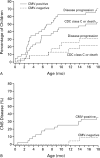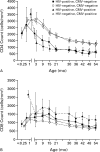Cytomegalovirus infection and HIV-1 disease progression in infants born to HIV-1-infected women. Pediatric Pulmonary and Cardiovascular Complications of Vertically Transmitted HIV Infection Study Group
- PMID: 10395631
- PMCID: PMC4280563
- DOI: 10.1056/NEJM199907083410203
Cytomegalovirus infection and HIV-1 disease progression in infants born to HIV-1-infected women. Pediatric Pulmonary and Cardiovascular Complications of Vertically Transmitted HIV Infection Study Group
Abstract
Background and methods: Cytomegalovirus (CMV) has been implicated as a cofactor in the progression of human immunodeficiency virus type 1 (HIV-1) disease. We assessed 440 infants (75 of whom were HIV-1-infected and 365 of whom were not) who had known CMV status and were born to HIV-1-infected women and who were followed prospectively. HIV-1 disease progression was defined as the presence of class C symptoms (according to the criteria of the Centers for Disease Control and Prevention [CDC]) or CD4 counts of less than 750 cells per cubic millimeter by 1 year of age and less than 500 cells per cubic millimeter by 18 months of age.
Results: At birth the frequency of CMV infection was similar in the HIV-1-infected and HIV-1-uninfected infants (4.3 percent and 4.5 percent, respectively), but the HIV-1-infected infants had a higher rate of CMV infection at six months of age (39.9 percent vs. 15.3 percent, P=0.001) and continued to have a higher rate of CMV infection through four years of age (P=0.04). By 18 months of age, the infants with both infections had higher rates of HIV-1 disease progression (70.0 percent vs. 30.4 percent, P=0.001), CDC class C symptoms or death (52.5 percent vs. 21.7 percent, P=0.008), and impaired brain growth or progressive motor deficits (35.6 percent vs. 8.7 percent, P=0.005) than infants infected only with HIV-1. In a Cox regression analysis, CMV infection was associated with an increased risk of HIV-1 disease progression (relative risk, 2.59; 95 percent confidence interval, 1.13 to 5.95). Among children infected with HIV-1 alone, but not among those infected with both viruses, children with rapid progression of HIV-1 disease had higher mean levels of HIV-1 RNA than those with slower or no progression of disease.
Conclusions: HIV-1-infected infants who acquire CMV infection in the first 18 months of life have a significantly higher rate of disease progression and central nervous system disease than those infected with HIV-1 alone.
Figures




Comment in
-
Infants with CMV and HIV-1.N Engl J Med. 1999 Nov 4;341(19):1476-7. doi: 10.1056/NEJM199911043411917. N Engl J Med. 1999. PMID: 10577105 No abstract available.
References
-
- Collier AC, Meyers JD, Corey L, Murphy VL, Roberts PL, Handsfield HH. Cytomegalovirus infection in homosexual men: relationship to sexual practices, antibody to human immunodeficiency virus, and cell-mediated immunity. Am J Med. 1987;82:593–601. - PubMed
-
- Detels R, Visscher BR, Fahey JL, et al. The relation of cytomegalovirus and Epstein-Barr virus antibodies to T-cell subsets in homosexually active men. JAMA. 1984;251:1719–22. - PubMed
-
- Drew WL, Mills J, Levy J, et al. Cytomegalovirus infection and abnormal T-lymphocyte subset ratios in homosexual men. Ann Intern Med. 1985;103:61–3. - PubMed
Publication types
MeSH terms
Substances
Grants and funding
- K01 RR000188/RR/NCRR NIH HHS/United States
- M01 RR000645/RR/NCRR NIH HHS/United States
- N01-HR-96039/HR/NHLBI NIH HHS/United States
- M01 RR000865/RR/NCRR NIH HHS/United States
- M01 RR000533/RR/NCRR NIH HHS/United States
- N01 HR096037/HR/NHLBI NIH HHS/United States
- M01 RR002172/RR/NCRR NIH HHS/United States
- M01 RR000188/RR/NCRR NIH HHS/United States
- M01 RR000071/RR/NCRR NIH HHS/United States
- M01 RR000043/RR/NCRR NIH HHS/United States
- N01-HR-96038/HR/NHLBI NIH HHS/United States
- N01 HR096043/HR/NHLBI NIH HHS/United States
LinkOut - more resources
Full Text Sources
Other Literature Sources
Medical
Research Materials
